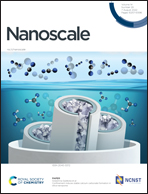Chiral biosensing at both interband transition and plasmonic extinction regions using twisted-stacked nanowire arrays†
Abstract
Chiral metal nanostructures that exhibit strong chiroptical properties and enhanced light–matter interactions have recently attracted great interest due to their potential applications including chiral sensing and asymmetric synthesis. Most studies in this field focused on chiral sensing using circular dichroism (CD) responses at the plasmonic extinction region. In comparison, little is known about their CD responses at interband transition regions and their utility in chiral biosensing. Herein, we constructed a series of twisted-stacked silver nanowire arrays (TNAs) featuring CD signals at both the interband transition and plasmonic extinction regions and that are independently controllable. These TNAs are highly sensitive towards protein secondary structures. Proteins containing more β-sheets are more sensitive toward strong chiral plasmonic fields, whereas proteins rich in α-helices tend to generate larger CD shifts at the interband transition region of TNAs. The mutually independent optical activities at the interband transition and plasmonic extinction regions complement each other, providing more sensitivity and reliability in chiral biosensing.



 Please wait while we load your content...
Please wait while we load your content...